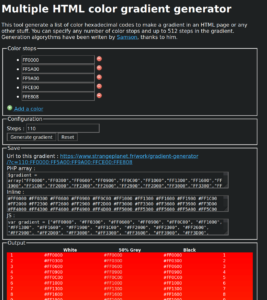People in the Middle East Disagree About a Lot of Things, But I’m Quite Sure That They All Agree That This Is the Silliest Android Bug Ever
There’s a popular podcast produced by the New York Times: Hard Fork. It talks about technology, and since a lot of people these days find it difficult to talk about technology without mentioning “AI”, the two Hard Fork hosts make two disclaimers in almost every episode: That the New York Times is suing OpenAI, and that the boyfriend of one of the hosts works for Anthropic, which makes the Claude conversation simulator.
There is, however, another thing that is common to both the New York Times and Anthropic, and it has nothing to do with “AI”. It’s that Android apps made by these two companies have the same bug, and this bug is mindbogglingly silly.
This bug makes countless Android apps partially or completely broken for anyone whose phone interface is set to Hebrew, Arabic, Persian, Urdu, or any other right-to-left (RTL) language. The most frustrating part? This widespread problem, which affects hundreds of millions of users globally, can be fixed by changing one line of code.
The Problem: When English Apps Go RTL
I use my Android phone with a Hebrew interface because, well, Hebrew is my language. I don’t expect all English-language apps to support Hebrew. The New York Times, for example, publishes almost everything in English, and that’s OK. The Claude app’s user interface is in English and hasn’t been localized to Hebrew, at least yet, and that’s not too bad either. I know English, and when I choose an English-language app, I just want it to work well in English.
What’s not fine is when these apps break because they’re trying to adapt to right-to-left languages when they have no business doing so. Apps try to do this because they see that my phone asks for Hebrew user interface. They are trying—and failing. The results are grim.
In the NYT Cooking app, recipe reviews get hidden behind star ratings, English text awkwardly aligns to the right, and ellipsis marks appear on the wrong side of photo captions. The app becomes harder to use despite being entirely in English.


The Claude AI app suffers from similar problems—interface elements flip inappropriately, making the English-language interface confusing and sometimes unusable.



Perhaps most dramatically, in 2019, I captured a screenshot from the Delta Air Lines app that showed a flight appearing to go from Atlanta to JFK when it was actually going from JFK to Atlanta.

While Delta seems to have fixed its app since 2019, it illustrates how RTL bugs can be genuinely misleading.
The Root Cause: Android Studio’s Default Behavior
The real culprit isn’t individual app developers—it’s Google’s Android development ecosystem. When developers create new Android apps using Android Studio, the most popular development tool, the default configuration includes android:supportsRtl="true" in the app’s configuration file, AndroidManifest.xml.
This setting tells Android to automatically flip the app’s layout for RTL languages. Google wants to encourage and simplify RTL language support for developers, but it goes too far: developers don’t even think that they need to do anything, and the result is broken.
The irony is that we’re living in an age of incredibly sophisticated AI and machine learning, yet this simple localization bug—which has nothing to do with advanced computer science—causes daily frustration for hundreds of millions of people.
The Scale of the Problem
This isn’t a niche issue. Consider the numbers:
- Arabic: more than 400 million speakers
- Urdu: more than 200 million speakers
- Persian: more than 110 million speakers
- Hebrew speakers: about 9 million speakers
- And there are other RTL languages: Punjabi, Uyghur, Yiddish, and more.
We’re talking about hundreds of millions of people who experience degraded app performance through no fault of their own. They’re not asking for their native language support—they just want English apps to work properly when their phone’s system language happens to be RTL. Because of problems like this, many of those people choose to use their phones in English and get all the apps in English, even though many of them don’t actually know English very well.
So please don’t tell me to switch my phone to English—it’s not actually a solution.
There’s another bitter irony in this situation. Hebrew speakers, Arabic speakers, and Persian speakers, are often divided by geopolitics and conflict. Yet we’re all united by the same stupid software bugs in the support for the languages that we speak, read, write, and love.
I’ve spoken with Palestinians, Saudis, Iranians, and Pakistanis about this issue. We all face the same broken apps, the same UI frustrations, the same feeling of being an afterthought in software design. Perhaps instead of fighting each other, we should unite in fighting these bugs—with code and constructive feedback, of course.
My Quixotic Quest for Fixes
I’ve become something of a Don Quixote in this fight, reporting this bug to dozens of companies. The responses have been telling:
- Most companies, including Anthropic: Complete silence.
- Some companies, including The New York Times, as well as Dave & Busters, italki, Citizens Bank, and a many, many more: Promised to fix it, but didn’t.
- A few apps, like Dunkin’ Donuts and Podcast Addict, actually got fixed as a result or my emails.

- One company, Drive Less, a local Rhode Island biking app, not only fixed it, but also sent me a $20 gift card.


- One more company, the Massachusetts Bay Transportation Authority, also known as the MBTA or “the T”, published the source code of its Android app on GitHub under a Free Software license, so I sent a fix, and they quickly merged it and released an update!¹



Despite the few positive examples at the end of this list, the pattern is clear: this is a fixable problem, but most companies don’t prioritize it because it doesn’t affect English-speaking decision-makers.
The Absurdly Simple Solution
Here’s the fix that would solve this problem in almost all affected apps:
In the AndroidManifest.xml file, change the line android:supportsRtl="true" to android:supportsRtl="false".
That’s it. One line.
This tells Android: “This app doesn’t support RTL layouts, so don’t try to flip anything.” The app will continue working normally in English, regardless of the user’s system language.
Apps that genuinely want to support RTL languages—which is commendable!—should keep the setting as "true", but then properly implement RTL layouts with appropriate testing and design considerations.
How to Make an Even Bigger Change
While individual app developers can fix it in their products, this is not really scalable. The real, big solution needs to happen at the platform level. Most importantly, Android Studio should change its defaults: New projects shouldn’t include RTL support unless developers explicitly opt in. I’m not sure how to fix it in all the existing apps, but at least in theory, it’s possible.
So What Can You Do
If you’re an Android developer, check your app’s RTL behavior. If you’re not intentionally supporting RTL languages, please set supportsRtl="false".
If you work at Google or influence Android development tools, please consider changing the default behavior to be opt-in rather than opt-out.
If you’re a user affected by these issues, don’t suffer in silence. Report bugs to app developers. Many don’t even know these problems exist. At least some of them will fix them.
Technology should work for everyone, regardless of which language they speak or which direction their language is written. This bug represents a small but important way that our interconnected world still fails to accommodate its own diversity.
The fix is simple. The impact would be enormous. All it takes is the will to change one line of code—and one default setting—at a time.
¹ Notably, the NJ Transit and the New York MTA’s TrainTime apps still have this bug, even though I’m quite sure that I reported it to them. In the battle of the state transportation agencies for not giving broken apps to people who use their phones in RTL languages, Massachusetts’ MBTA wins big time for now!


























